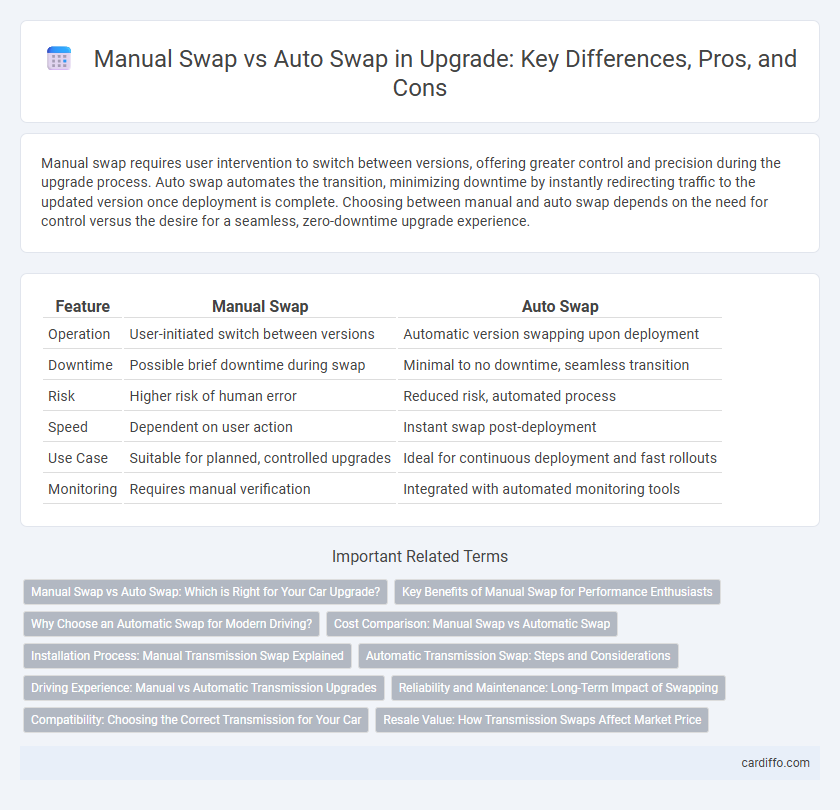Manual swap requires user intervention to switch between versions, offering greater control and precision during the upgrade process. Auto swap automates the transition, minimizing downtime by instantly redirecting traffic to the updated version once deployment is complete. Choosing between manual and auto swap depends on the need for control versus the desire for a seamless, zero-downtime upgrade experience.
Table of Comparison
| Feature | Manual Swap | Auto Swap |
|---|---|---|
| Operation | User-initiated switch between versions | Automatic version swapping upon deployment |
| Downtime | Possible brief downtime during swap | Minimal to no downtime, seamless transition |
| Risk | Higher risk of human error | Reduced risk, automated process |
| Speed | Dependent on user action | Instant swap post-deployment |
| Use Case | Suitable for planned, controlled upgrades | Ideal for continuous deployment and fast rollouts |
| Monitoring | Requires manual verification | Integrated with automated monitoring tools |
Manual Swap vs Auto Swap: Which is Right for Your Car Upgrade?
Manual swap offers precise control over the timing and sequence of gear changes, making it ideal for drivers who prioritize a personalized driving experience and enhanced control. Auto swap provides seamless gear transitions through automated systems, enhancing convenience and consistency, especially in heavy traffic or urban environments. Evaluating factors such as driving style, vehicle type, and upgrade goals is essential to determine whether a manual or auto swap best suits your car upgrade needs.
Key Benefits of Manual Swap for Performance Enthusiasts
Manual swap offers precise control over hardware and software upgrades, allowing performance enthusiasts to fine-tune components for optimal efficiency. This hands-on approach enables immediate testing and customization, enhancing system responsiveness and stability. By manually selecting and installing parts, users can ensure compatibility and maximize the performance potential of their machines.
Why Choose an Automatic Swap for Modern Driving?
Automatic swap offers seamless gear transitions that enhance driving comfort and reduce driver fatigue, particularly in stop-and-go city traffic. Modern automatics leverage advanced sensors and adaptive algorithms to optimize fuel efficiency and engine performance, outperforming manual gear control. Choosing an automatic swap ensures smoother acceleration, improved safety, and greater ease of use for diverse road conditions.
Cost Comparison: Manual Swap vs Automatic Swap
Manual swap incurs lower upfront costs due to minimal automation requirements but demands increased labor expenses and potential downtime, impacting overall operational efficiency. Automatic swap systems require higher initial investment for technology integration yet reduce long-term costs by minimizing human error, decreasing downtime, and streamlining processes. Evaluating total cost of ownership reveals that automatic swaps often provide better value over time through improved productivity and reduced maintenance overhead.
Installation Process: Manual Transmission Swap Explained
Manual transmission swaps require detailed disassembly and reassembly of drivetrain components, involving removal of the existing automatic transmission and installation of the manual gearbox, clutch assembly, and associated hardware. The process demands precise alignment of the clutch, flywheel, transmission mount, and linkage adjustments to ensure proper functionality and shift quality. Installing a manual transmission often necessitates modifications to the driveshaft, hydraulic clutch system, and installation of a pedal assembly, making it more labor-intensive compared to automatic swaps.
Automatic Transmission Swap: Steps and Considerations
Automatic transmission swap involves selecting a compatible transmission model based on vehicle make and engine type, followed by removing the old transmission and installing the new unit with precise alignment to the engine. Essential considerations include updating the transmission control module, ensuring proper fluid compatibility, and verifying electronic sensor connections for optimal performance. Final steps require thorough testing to confirm smooth gear shifts and system integration, preventing potential mechanical issues.
Driving Experience: Manual vs Automatic Transmission Upgrades
Manual transmission upgrades enhance driving control and engagement, allowing precise gear shifts tailored to driver input, which improves performance and responsiveness on varied terrains. Automatic transmission upgrades offer smoother gear transitions, reducing driver fatigue and providing consistent acceleration, especially beneficial in stop-and-go traffic conditions. Both upgrades significantly impact driving experience, with manual focusing on driver involvement and automatic prioritizing convenience and comfort.
Reliability and Maintenance: Long-Term Impact of Swapping
Manual swap processes often introduce human error, increasing the risk of system downtime and inconsistent performance, which can weaken long-term reliability. Auto swap mechanisms enhance system stability by automating transitions, reducing operational risks and maintenance requirements. This automation supports prolonged system health, minimizing the frequency of manual interventions and ensuring smoother upgrade cycles.
Compatibility: Choosing the Correct Transmission for Your Car
Manual swap transmissions offer greater compatibility across diverse vehicle models, allowing for customization tailored to specific engine and drivetrain configurations. Auto swap transmissions require precise matching to the vehicle's electronic control systems and often need programming adjustments to ensure seamless integration. Selecting the correct transmission type hinges on evaluating compatibility with your car's mechanical setup and electronic architecture for optimal performance.
Resale Value: How Transmission Swaps Affect Market Price
Manual transmission swaps often increase resale value by appealing to driving enthusiasts who value control and engagement, making the vehicle more desirable in niche markets. Auto transmission swaps typically broaden market appeal, attracting a wider range of buyers seeking convenience, which can stabilize but not significantly boost resale prices. Vehicles with original or carefully executed transmission swaps retain higher market value compared to those with poorly done or mismatched swaps that may deter potential buyers.
manual swap vs auto swap Infographic

 cardiffo.com
cardiffo.com